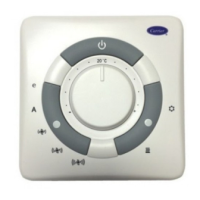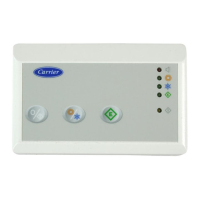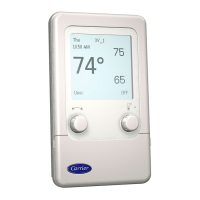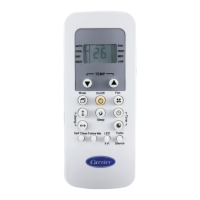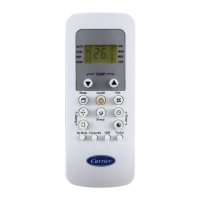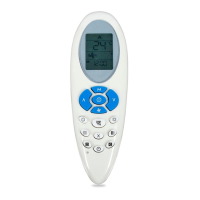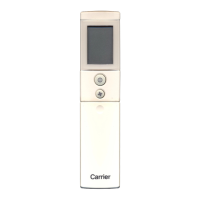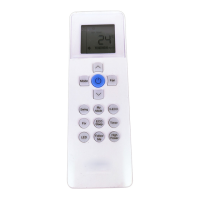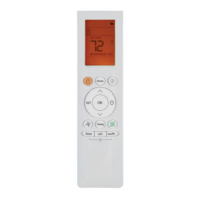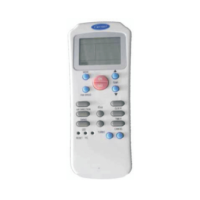<Controller Name>
Day of Week:
Time: 13:51
Holiday Today: Yes
Day of Month: 22
Month: 02
Year: 03
< Text & Error messages >
Fig. 17 -- Time and Date Screen
Confiouration Tables
BROCASTS
HOLIDAYS
LIMITS
SNSRCONF
ZNCONFIG
< Text & Error messages >
Fig. 18 -- Table List Screen
The top line shows the name of the table that was selected.
The bottom line shows text and error messages, as applicable.
The center portion of the screen lists the associated tables in
alphabetical ordel: If the list has mole than 7 tables, then the
Iil_t 7 tables will be displayed.
Use the SCROLL UP/DOWN buttons or the NAVIGATE
knob to scroll through the list. If thele are more than 7 tables,
pressing PAGE UP/DOWN will display the previous or next 7
names fiom the list. Press the SELECT button to lead the
highlighted table fi_)m the attached device trod display an
appropriate screen. A Time Schedule screen is displayed if the
table is a time schedule, or a Standard Table screen is displayed
for any other table. Pressing the EXIT button causes the
System Pilot to return to the Table List screen.
Standard Table Screen -- ff a table type with a single table
entry is selected from a Table List screen, or a table (other than
a schedule) is selected from a Table List screen, the System
Pilot displays a Standard Table screen.
The top line shows the 8-character table name. The center
portion of the screen shows the table &tta. Dynamic table
data (display and maintenance) is lead fi_m the attached device
and updated on the screen every 15 seconds. If a read attempt
(one try plus five letries) fails, the System Pilot will display
"C" (gray background) after the point nalne in each data
line. An error message is displayed on the bottom line
("Communication failure"). If the EXIT button is pressed, the
System Pilot returns to the Program scleen.
Static table <a (configuration, set points and service
configuration) is lead from the attached device once, when
the table is first selected and displayed. There will be one point/
decision per line. If there me more than seven decisions/points,
the first seven will be displayed initially. The bottom line
displays text and error messages, as applicable.
Use the SCROLL UP/DOWN buttons or the NAVIGATE
knob to scroll through the data. If there me more than 7 deci-
sions/points, plessing PAGE UP/DOWN will display the
previous or next 7 nmnes from the list. As the user scrolls
through the table, the System Pilot will highlight the current
decision/point and if it there is an associated point nmne, the
24-chm'acter descriptor will be displayed on the bottom line. If
there is no associated point name, the System Pilot will display
the 24-character descriptor in the center portion of the screen.
The operation of the SELECT button varies, depending on
whether the user is viewing dynamic or static table &tta. For
dynamic table data, if the SELECT button is pressed and the
current point is forcible, the System Pilot will force or auto the
point. If the current value is not forcible, the System Pilot will
ignore the SELECT button.
For static table data, if the SELECT button is pressed and
the current point is editable, the System Pilot allows the user to
modify the point.
NOTE: For strings truncated for display. NAVIGATE will
adjust a sliding window of as many characters as can fit on the
line.
For ASCII decisions with a list-selectable value, the System
Pilot will display a Configuration List screen with the available
values. If the cunent decision has a list-selectable value but the
System Pilot is unable to obtain the list, it will display an
appropriate error message. Pressing the EXIT button causes the
System Pilot to return to the Program screen.
Configuration List Screen -- If the user presses the SELECT
button while the System Pilot is displaying static table data
(for example, a configuration table) and the current decision
has a list-selectable value, the System Pilot will display a
Configuration List screen. This type of screen will be displayed
for certain configuration decisions in the Universal Controller
and the Zone Controller as well as for certain decisions in the
System Pilot's REMOTE table.
The top line shows the decision's 24-character descriptor.
truncated if necessmy. The bottom line displays error messag-
es, if applicable. The center portion of the screen shows the
awdlable values (text strings) for the decision. There will be
one text string per line, truncated if necessary.
Use the SCROLL UP/DOWN buttons or the NAVIGATE
knob to scroll through the list. If thele are more than 7 text
strings in the list, pressing PAGE UP/DOWN will display the
previous or next 7 text strings from the list. If the SELECT
button is pressed, the System Pilot will return to the Standiud
Table screen and will show the selected text string as the
cunent decision value. The System Pilot will display the
decision value as text; however, it stores the value in the table
according to the decision's &_ta type and limits. Pressing the
EXIT button will cause the System Pilot to _eturu to the
Stan&trd Table screen without updating the current decision.
SCHEDULE- Selecting the SCHEDULE option fiom the
Program screen and then selecting a Time Schedule table
displays the Time Schedule screen as shown in Fig. 19. This
exmnple shows all 8 of the time schedule periods, even though
only the first 6 (plus the header line) will actually be shown on
the System Pilot when this screen is entered.
The top line shows the 8-character schedule name. The bot-
tom line displays text and error messages, if applicable. The
center portion of the screen shows the schedule datxt which are
the occupied and unoccupied times for each period and the
days to which the period applies. The time is displayed with a
24-hour clock with colon (00:00 to 24:00). The day flags are
displayed as 8 bits (0 or 1), for Mon&ty through Sunday plus
holi&ty. The times and day flags are modifiable. The period
numbers and the header line are fixed. Each of the &ty flags is
treated as a sep_u'ate field, therefore, there are 12 modifiable
fields per line.
Use the SCROLL UP/DOWN buttons or the NAVIGATE
knob to scroll through the table one line at a time. If the
SELECT button is pressed, the System Pilot allows the user to
modify the data on the cunent line (starting with Occupied
hour). Use the NAVIGATE knob to move within the line. As
10
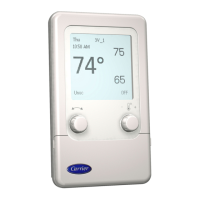
